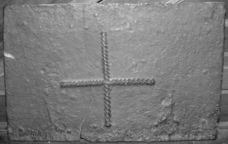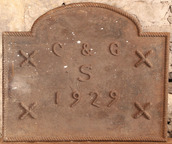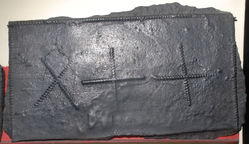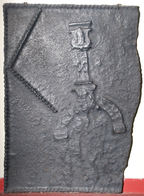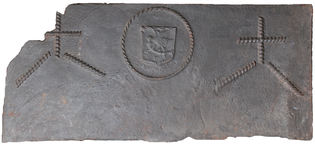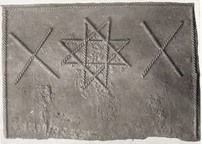-
115
Description: Plain rectangular plate with cross formed of a single length of twisted rope placed twice.
Notes: Despite the simple form, the likely Christian symbolism is very evident. Formerly part of the Ade Collection (from Grove Hill, Hellingly, Sussex).
- Decoration tags:
- rectangular (shape)
- none (edging)
- simple stamps
- apotropaic
- objects
Manufactured: in the 16th century in the Weald area of England.
Current location: Hastings Museum and Art Gallery, John's Place, Bohemia Road, Hastings, East Sussex, England.
Museum number: HASMG: 1952.51.17 (part of the Hastings Museum museum group)
- Attached to series:
- Rope design firebacks
-
169
Description: Rectangular; twisted rope edging (top and sides); inscription made of short lengths of twisted rope, irregularly spaced across upper middle, central device formed of a Tudor 'A' with overstamped 'V'.
Notes: It is not clear if the central device is a monogram, or if it might have apotropaic significance.
Inscription: T A M T
- Decoration tags:
- rectangular (shape)
- rope (edging)
- simple stamps
- apotropaic
- text
- objects
Manufactured: in the early- to mid-16th century in the Weald area of England.
Current location: Hastings Museum and Art Gallery, John's Place, Bohemia Road, Hastings, East Sussex, England.
Museum number: HASMG: 1911.60.7 (part of the Hastings Museum museum group)
Citation: Page, S. & Wallace, M. (eds.), 2018, Spellbound (Oxford, Ashmolean Museum), p. 72.
- Attached to series:
- Rope design firebacks
-
921
Description: Canted rectangle; twisted rope edging (top and sides); central arrow-shaped design formed of three repeated rope lengths.
Notes: The arrow design probably has an apotropaic (evil-averting) purpose, perhaps intended as the initials VV for 'virgo virginum'.
- Decoration tags:
- rectangular with canted top corners (shape)
- rope (edging)
- simple stamps
- apotropaic
- objects
Manufactured: in the 16th century in the Weald area of England.
Current location: in private hands, Heathfield, East Sussex, England.
- Attached to series:
- Rope design firebacks
-
1118
Description: Rectangular; twisted rope edging (top and sides); initials in top corners; below the initials, a saltire formed of possibly two straight lengths of twisted rope.
Notes: The saltire is likely to have an apotropaic purpose; the hollows in the risers of the letter 'H' and the end of the left line of the saltire may have been formed by gas bubbles in the molten iron during casting.
Inscription: N H
- Decoration tags:
- rectangular (shape)
- rope (edging)
- simple stamps
- individual letters
- apotropaic
- text
Manufactured: in the early- to mid-17th century in England.
Current location: in private hands, Isleworth, London, England.
- Attached to series:
- Rope design firebacks
-
1172
Description: Rectangular; twisted rope edging (top and sides); to each side, two saltires formed of crossed lengths of twisted rope; in between, and repeated seven times, a circular stamp decorated in low relief with a central disc perforated in the centre, surrounded by a circle inside a square looped at each corner, the sides of which are echoed twice on each side; the stamps are arranged in two rows, of three and four, in the upper part of the plate.
Notes: A boldly cast fireback with an excrescence top centre caused by disturbance of the casting sand by the pouring of the iron.
- Decoration tags:
- rectangular (shape)
- rope (edging)
- simple stamps
- carved stamps
- apotropaic
- objects
Manufactured: in the late-16th to early-17th century possibly in the Weald area of England.
Current location: Retrouvius, 1016 Harrow Road, Kensal Green, Brent, London, England.
- Attached to series:
- Food mould stamp firebacks
- Rope design firebacks
-
1156
Description: Arched rectangular shape; stylised twisted rope edging; centred, 'C & G' above 'S' above '1929', all between four stylised rope saltires.
Notes: A twentieth century fireback designed and executed in a traditional form.
Inscription: C & G / S / 1929
- Decoration tags:
- rectangular with round arch (shape)
- rope (edging)
- carved stamps
- individual letters
- individual numbers
- text
- objects
Manufactured: in 1929 in England.
Current location: Lacock Abbey, Lacock, Wiltshire, England.
Museum number: 1545478 (part of the National Trust museum group)
- Attached to series:
- Rope design firebacks
-
374
Description: Quasi-rectangular; twisted rope edging (top and sides); a length of twisted rope stamped six times to form a saltire and two crosses across the width of the plate; surplus iron extends from all sides.
Notes: The surplus iron resulted from over filling of the mould. The crosses are likely to have Christian significance. Formerly part of the J. H. Every collection.
- Decoration tags:
- rectangular (shape)
- rope (edging)
- simple stamps
- apotropaic
- objects
Manufactured: in the mid- to late-16th century in the Weald area of England.
Current location: Anne of Cleves House, Southover High Street, Lewes, East Sussex, England.
Museum number: 1944.24.037 (part of the Sussex Archaeological Society museum group)
Citation: Hughes, G. B., May 1940, 'Old English Firebacks', Apollo, 31, 185, pp. 117-120.
- Attached to series:
- Rope design firebacks
-
378
Description: Fragment (left end only); prob. rectangular; twisted rope edging; slightly angled stamp formed of the end of a firedog with semi-circular feet, and shields at the base and top of the pilaster; V-shaped arrangement of a length of twisted rope stamped twice, the point touching the left edge of the plate and one end touching the top.
Notes: Likely to have been a triple arrangement of firedog impressions.
- Decoration tags:
- rectangular (shape)
- rope (edging)
- simple stamps
- apotropaic
- objects
Manufactured: in the mid- to late-16th century in the Weald area of England.
Current location: Anne of Cleves House, Southover High Street, Lewes, East Sussex, England.
Museum number: LH000.911 (part of the Sussex Archaeological Society museum group)
- Attached to series:
- Firedog stamp firebacks
- Rope design firebacks
- Metalware stamp firebacks
-
435
Description: Rectangular (damaged top left corner); plain plate; centre top, a circle of twisted rope enclosing a shield, indented at the top, charged with a bird upon a branch; on each side, a cross of twisted rope above two splayed lengths of rope.
Notes: The rope design is likely to be apotropaic; the heavily pitted reverse of this fireback shows the use of poor quality iron cast at a relatively low temperature; the bird shield stamp has been seen on other firebacks.
- Decoration tags:
- rectangular (shape)
- none (edging)
- simple stamps
- carved stamps
- apotropaic
- armorial
- objects
Manufactured: in the early- to mid-16th century in the Weald area of England.
Current location: Anne of Cleves House, Southover High Street, Lewes, East Sussex, England.
(part of the Sussex Archaeological Society museum group)
- Attached to series:
- Bird shield series
- Rope design firebacks
-
437
Description: Sub-rectangular; twisted rope edging (top and sides); centre, straight length of twisted material (rope or metal) stamped eight times to form an octagram, and twice on each side to form saltires.
Notes: The octagram has magical symbolism, allegedly providing protection against evil; it is more commonly seen on French firebacks. Formerly part of the J. H. Every collection. Illustration from Schubert, 1957.
- Decoration tags:
- rectangular (shape)
- rope (edging)
- simple stamps
- apotropaic
- objects
Manufactured: in the 16th century in the Weald area of England.
Current location: Anne of Cleves House, Southover High Street, Lewes, East Sussex, England.
Museum number: 1944.24.038 (part of the Sussex Archaeological Society museum group)
Citation: Mercer, H. C., 1961, The Bible in Iron (3rd ed. Doylestown, The Bucks County Historical Society).
- Attached to series:
- Rope design firebacks
